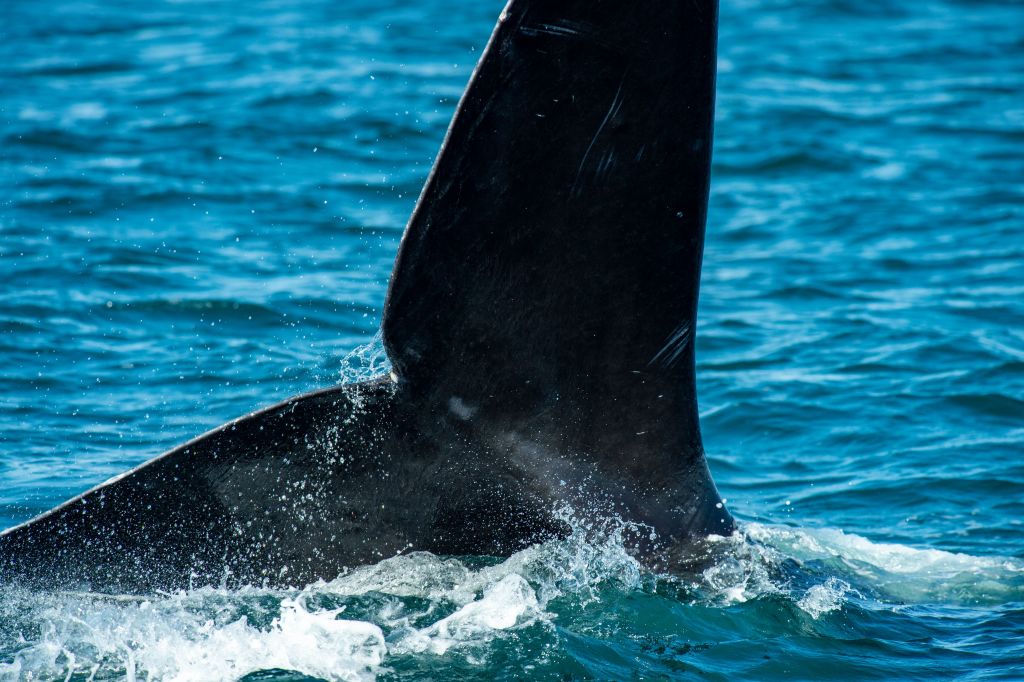According to Donald Trump, wind turbines are killing whales at unprecedented rates. The former president’s remarks came during a speech in South Carolina last week during which he criticized President Joe Biden for a potential expansion of speed regulations intended to reduce collisions between boating vessels and the endangered North Atlantic right whale. The rule alterations, which were proposed by the National Oceanic and Atmospheric Administration (NOAA) last year, would broaden speed restrictions to cover more vessels and increase both the size and effective time frame of seasonal speed restriction areas off the East Coast. “The Biden administration is right now trying to bludgeon the boating and maritime industry,” Trump said. “This is supposedly in the name of preventing whale strikes, but you have a better chance of being struck by lightning than hitting a whale with your boat.”
Instead, Trump claims, the main culprit of whale deaths is actually offshore wind turbines—the expansion of which the Biden administration has widely supported. “On the other hand, their windmills are causing whales to die in numbers never seen before, nobody does anything about that,” Trump continued. “They’re washing up on shore. I saw it this weekend, three of them came up. You wouldn’t see it once a year, now they’re coming up on a weekly basis. The windmills are driving them crazy. They’re driving the whales, I think, a little batty.”
Because there is no reliable data on the total number of whale collisions nationwide or the total number of maritime vessels passing through particular areas, whether one is more likely to be the victim of a lightning strike or hit a whale with a boat is exceedingly difficult to determine. The odds of getting struck by lightning are about 1 in 15,300 according to the Encyclopedia Britannica.
Trump’s claim that he saw three whales wash up in one weekend, however, is likely false. According to a member of the NOAA’s Greater Atlantic Regional Fisheries Office, the only East Coast whale stranding over the past two weeks was a single sperm whale calf found in Florida on Wednesday, two days after the former president’s remarks.
Trump is correct, however, that an unusually large number of whales have been dying in recent years—so much so that the NOAA declared an Unusual Mortality Event because of the sharp increase in North Atlantic right whale strandings since 2017. There were 36 North Atlantic right whale deaths and 34 serious injuries recorded by the NOAA between January 2017 and July 2023, and an Unusual Mortality Event was also declared for humpback whales the same year: 200 humpback whale mortalities have been recorded by the NOAA off the East Coast since January 2016—nearly twice the previous four years’ annual average. That said, there is currently no evidence that wind turbines are at fault for this spike in whale deaths.
“At this point, there is no scientific evidence that noise resulting from offshore wind site characterization surveys could potentially cause mortality of whales,” the NOAA states. “There are no known links between recent large whale mortalities and ongoing offshore wind surveys.” Of the 36 documented right whales killed since 2017, 12 were identified as the consequence of vessel strikes, nine because of entanglements in fishing gear, and two were perinatal deaths. Similarly, 31 of the 34 serious injuries were due to entanglements and two were from vessel strikes. Of the 90 stranded humpback whales that the NOAA has examined since the declaration of the Unusual Mortality Event, about 40 percent exhibited signs of either ship strike or entanglement, with most of the other deaths being attributed to factors like starvation or organ damage.
That said, many whale deaths are not documented, and even when they are, researchers are often unable to determine a specific cause of death. Acoustic trauma would be particularly challenging to identify because, in many whales, certain parts of the ear decompose within hours of death. “Generally, the state of decomposition plays a big role and it can make it really hard for us to determine a definitive cause of death,” Sarah Wilkin, coordinator of the Marine Mammal Health and Stranding Response Program said in a January 2023 press call.
While wind turbines and their construction do not appear to be linked to whale mortality, the surveying techniques used in planning and certain construction techniques certainly can be disruptive to nearby marine life, including whales. “Wind farm installations can have a detrimental impact on marine mammals during the construction phases,” Dr. Kevin Robinson, executive director of the U.K.-based Cetacean Research & Rescue Unit, tells The Dispatch Fact Check. “The extraneous noise from piling potentially [causes] injury to these animals, and at the very least [causes] displacement, masks communication, etc.” A 2006 study arrived at similar conclusions, stating that “pile-driving and other activities that generate intense impulses during construction are likely to disrupt the behavior of marine mammals at ranges of many kilometers,” and that “these activities have the potential to induce hearing impairment at close range.” The study also found, however, that once in operation, turbines themselves had little impact on marine mammals in general.
The NOAA is fully aware of these potential disturbances, and has deployed a number of strategies to limit their impact. For example, the administration requires offshore wind operators to apply for special “Level B” incidental harassment authorizations in cases where animals may be disturbed, and many vessels conducting construction and surveying activities are required to host a protected species observer to ensure that all applicable compliance requirements are met.
So, are wind turbines themselves making whales a bit “batty”? No, probably not. However, the noise caused by certain activities during the construction phase certainly does have some negative impact on nearby marine life, including whales. There is no proof at this point that there is any link between these sonic disturbances and the rise in both North Atlantic right and humpback whale mortalities in the northeastern U.S., but the NOAA and the Department of Energy are continuing to research and monitor the situation.
If you have a claim you would like to see us fact check, please send us an email at factcheck@thedispatch.com. If you would like to suggest a correction to this piece or any other Dispatch article, please email corrections@thedispatch.com.







Please note that we at The Dispatch hold ourselves, our work, and our commenters to a higher standard than other places on the internet. We welcome comments that foster genuine debate or discussion—including comments critical of us or our work—but responses that include ad hominem attacks on fellow Dispatch members or are intended to stoke fear and anger may be moderated.
With your membership, you only have the ability to comment on The Morning Dispatch articles. Consider upgrading to join the conversation everywhere.